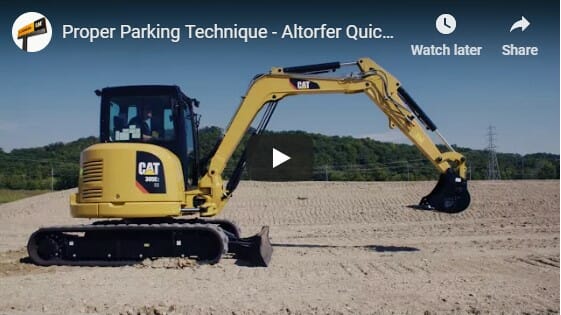- EQUIPMENT
- ATTACHMENTS
- POWER SYSTEMS
- TECHNOLOGY
- AGRICULTURE
May 13, 2019

When your team is working on a job, everyone has to be focused and follow the contract. But even when the day’s work is done, you still have to make sure you take care of your equipment. Cooling down your machinery and parking it properly helps keep it in the best condition possible.
Follow these simple parking techniques to ensure your excavator stays safe between jobs.
Hey, I’m Collin and this is today’s quick tip.
Today I’m going to show you how to properly park your CAT mini hydraulic excavator.
Proper parking technique is important to protect yourself, your machine and those around you.
First, reduce your engine speed as you approach your parking location.
Ensure that your parking location is on level ground.
Lower your blade and extend the stick and bucket, lowering the boom until your bucket is resting on the ground.
In freezing conditions be sure to park the machine on boards to prevent the tracks from freezing to the ground.
Next, raise the hydraulic control console to disengage the hydraulic control system.
Be sure to run the engine for five minutes at low idle to avoid engine overheating.
Now you can shut down the machine.
Move the controls to relieve any working pressure.
Now you’re ready to exit the cab using three points of contact.
Now the machine is parked safely and ready to go back to work soon.
As always consult your operation and maintenance manual for more information.
That was today’s quick tip.
Thanks for watching.
At the end of each workday, you don’t just shut off your machinery and leave it where it is. Moving it to the right parking location and shutting the machine down properly helps keep it in better shape so you can continue using it for many years.
First, you have to find the right place to park your machines. If you have an indoor space, you have an easy decision. But if you’re keeping it outside, you need to find level ground. After you find the right place, you need to slow the machine down as you approach the spot.
After you move the machine into the right position, lower the blade and the bucket so they are both resting on the ground. If you are working in freezing temperatures and you park your machinery outside, lay down wooden boards on the ground and park on top of them. This keeps the tracks from freezing to the ground.
Now that the machine is in the right position, you still have a few steps to go. Once the machine is parked, disengage the control system and let it idle with the engine running for about five minutes so it doesn’t overheat. Then, wiggle the controls a little bit to relieve any leftover pressure and turn off the machine.
When you’re exiting the machine, be sure to use your three points of contact as you’re stepping down.
Using the right techniques to park your machinery will help you maintain a safer environment. These techniques protect the driver, the machine itself and the people working around it.
Taking precautions like these helps prevent accidents that can cause injuries and damage to your machinery. When something like this happens, it leads to pricey repairs and delays in the work schedule.
These parking techniques and other maintenance checks and procedures help prevent accidents. Even when you’re as careful as possible, accidents can happen — but taking these steps can reduce their likeliness.
Your machinery works hard for you every day. Over time, even if you’re careful, your machinery will need maintenance. Completing parking techniques and checks will show when you need maintenance and repairs much sooner than waiting for the machine to break down.
When you need maintenance and repairs, trust Altorfer Cat to get your machine back in working order. We have 29 locations in 24 different cities and more than 60 years of experience. To learn more about our services or schedule maintenance, contact us today or give us a call at 800-333-5993
.